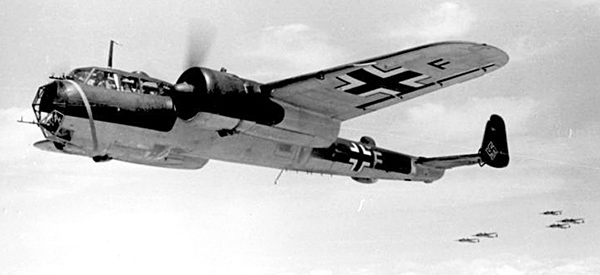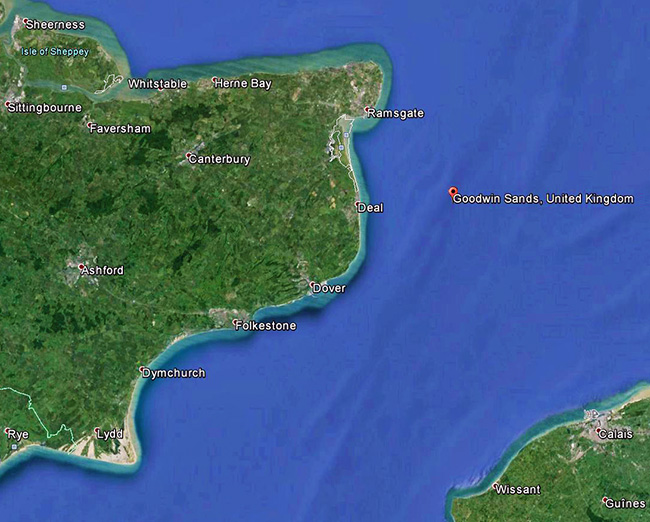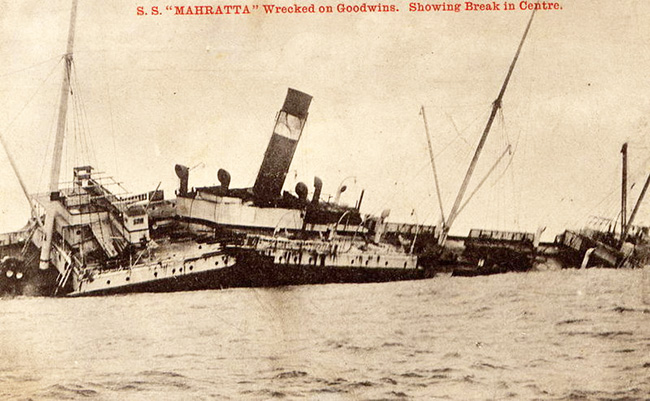Goodwin Sands
Today, the Goodwin Sands. The University of Houston's College of Engineering presents this series about the machines that make our civilization run and about the people whose ingenuity created them.
The Manager of the Royal Air Force Museum laid a wreath on the grave of Heinz Huhn in 2013. Huhn had been the bombardier on a German Dornier-17 during the Battle of Britain, in 1940.

A flight of Dornier-17s (Image courtesy of Wikimedia Commons)
That wreath-laying is not a ceremony we'd ever expect to see. But another event took place that same day: The wreck of Huhn's plane was retrieved from the Goodwin Sands, off the coast of Kent. British interceptors had caught the bomber and shot out both its engines. It came down in that eastern arm of the English Channel.
That would've been the end of it. But the Goodwin Sands are a strange feature. They lie - sometimes above, sometimes below - the water, in a 12-mile strip, part of it visible at low tide. The skinny Dornier, called the Flying Pencil, was a staple of the German raids. And it crashed and upended on the submerged sand. Two of her crew survived. Two, one of them Huhn, died of injuries.
Sea and sand quickly hid the bomber from sight, just as they've hidden most of the 2000 or so ships that've perished there. When divers found it in 2008, the Museum realized it was the only complete Dornier-17 still in existence, shabby as it might be. As of this writing the restoration goes on, fragment by fragment, in a chemically controlled environment.
And that wreath? Well, Huhn is now linked to the Museum. And I think of the essentially English commentary on war by A. E. Housman in his A Shropshire Lad, and in other poems. He wrote:
Here dead we lie
Because we did not choose
To live and shame the land
From which we sprung.
Life, to be sure,
Is nothing much to lose,
But young men think it is,
And we were young.
We were glad that Huhn was killed before he did further damage. But he was no less dead than all the others - on both sides of a terrible war.
Meanwhile, those Goodwin Sands lie, alongside Kent. They ate ships voraciously for millennia. Then they showed they could eat airplanes as well. The Sands can't hold lighthouses. So, before electronic navigational aids, what to do? Two lighthouses on the Kentish coast were visible just beyond the Sands on reasonably clear nights. Then lightshipswere posted near the sands. But, in 1954, a gale drove one of them into the sands and sank it, leaving only one survivor out of a crew of seven or so.

Satellite view of the location of the Goodwin Sands, submerged. (Image courtesy of Google Earth)
Old legends tell of an island named Lomea in that spot, but nothing verifiable. A low-tide cricket match was played annually on the Sands for over a century. And, since 1968, engineers have considered using the Sands as the platform for a large airport. As for the bomber's crew, one survivor became an antiwar activist. And Huhn's body, washed ashore, now rests in a German cemetery in central England - far from either the Sands, or from Germany.
I'm John Lienhard at the University of Houston, where we're interested in the way inventive minds work.
N. Calder, The English Channel. (NY: Viking, 1986): Chapter 17.
Beautifully illustrated article about the Dornier-17 in the Daily Mail.
See Wikipedia articles on Goodwin Sands and South Foreland Lighthouse. Learn about Heinz Huhn and his crew here.
The poem I quote, though not part of A. E. Housman's A Shropshire Lad, is often put with it and uses its recurring ghostly voice of a young soldier. See, e.g., Item XXXVI in this set.

Two S. S. Mahratta's, each bound for Calcutta, went aground on the Goodwin Sands. This is the second one (1939). The first was in 1909. (Image courtesy of Wikimedia Commons.
This episode was first aired on Feb 17, 2014